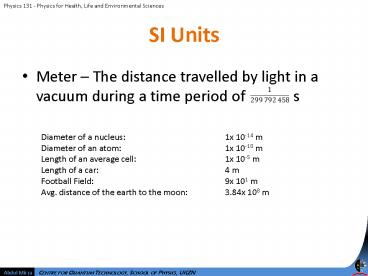SI Units - PowerPoint PPT Presentation
1 / 12
Title:
SI Units
Description:
Unit Conversions. Physics 131 - Physics for Health, Life and Environmental Sciences ... Multiply through by the conversion ratio. Convert 10 000s to hours. 4 ... – PowerPoint PPT presentation
Number of Views:81
Avg rating:3.0/5.0
Title: SI Units
1
SI Units
Physics 131 - Physics for Health, Life and
Environmental Sciences
- Meter The distance travelled by light in a
vacuum during a time period of s
Diameter of a nucleus 1x 10-14 m Diameter of
an atom 1x 10-10 m Length of an average cell
1x 10-5 m Length of a car 4 m Football
Field 9x 101 m Avg. distance of the earth to
the moon 3.84x 108 m
2
SI Units
Physics 131 - Physics for Health, Life and
Environmental Sciences
- Kilogram The exact weight of a specific
cylinder of a platinum-iridium alloy housed at
the International Bureau of Weights and
Measures, France
Electron 9.1x 10-31 kg Mosquitoe 1x 10-5
kg Human 1x 102 kg Elephant 5x 103 kg Earth
5.98x 1024 kg
3
SI Units
Physics 131 - Physics for Health, Life and
Environmental Sciences
- Second 9 192 631 770 times the period of the
radiation emitted from a caesium atom
Duration of a nuclear collision 1x 10-22
s Reaction time of humans 2x 10-1 s Time
difference between 1st and 2nd position at
indycar race 1.4 s (difference in price
money 650 000) 1 year 3.2x 107
s Calculated age of the universe 5x 1017 s
4
Unit Conversions
Physics 131 - Physics for Health, Life and
Environmental Sciences
- How do we shift a quantity between units?
- Multiply through by the conversion ratio
- Convert 10 000s to hours.
5
Types of Quantities
Physics 131 - Physics for Health, Life and
Environmental Sciences
- A quantity is measurable property of an object.
- A Car
No. of seats
Distance travelled
Temperature
Height
Speed
Length
All these quantities just have a magnitude -
Scalars
6
Types of Quantities
Physics 131 - Physics for Health, Life and
Environmental Sciences
- Lets look at the car again
Distance covered from a certain point
Air friction against motion of car
Displacement
Drag Force
Speed in a particular direction
Velocity
The above quantities, together with a magnitude,
act or have acted in a specific direction.
7
Scalars vs. Vectors
Physics 131 - Physics for Health, Life and
Environmental Sciences
- Scalars
- Has magnitude only
- Distance The physical length of a path between
two points. - Speed The rate of change distance.
- Mass The quantity of matter of a particular
object.
- Vectors
- Has magnitude and direction
- Displacement The line-of-sight distance from
one point to another. - Velocity The rate of change of displacement in
a particular direction. - Weight The gravitational force exerted on an
object by the earth.
8
Vectors
Physics 131 - Physics for Health, Life and
Environmental Sciences
- Vectors have magnitude and direction.
- In Cartesian co-ordinates, one can represent
them as arrows. - The length of the arrow is the magnitude.
- The direction of the arrow is the direction of
the vector.
Each axis has a basic vector from which all
others can be constructed Basis Vectors
z-axis
y-axis
x axis, i vector (1,0,0)
x-axis
y axis, j vector (0,1,0)
z axis, k vector (0,0,1)
i j k 1
9
Vectors
Physics 131 - Physics for Health, Life and
Environmental Sciences
Vectors by convention always start at the
origin The yellow vector, r, can be written as
the sum of all the smaller base vectors r 2i
3j 6k (2,3,6)
- We can split the motion up into three components
- X component - x 2i
- Y component - y 3j
- Z component - z 6k
10
Vectors
Physics 131 - Physics for Health, Life and
Environmental Sciences
To calculate the magnitude of a vector, one uses
Pythagoras Construct the vector, R
(x,y) R (3,9) R (-2,4) R 6i -1j What
is the magnitude and direction of each vector?
R
y
x
11
Components of Vectors
Physics 131 - Physics for Health, Life and
Environmental Sciences
To calculate the components of a vector, one uses
trig rules x Rcos? y Rsin?
R
y
?
x
12
Mathematics of Vectors
Physics 131 - Physics for Health, Life and
Environmental Sciences
- Vectors can be added/subtracted to/from each
other, however the direction is important. - A vector can be multiplied by a scalar. The
result is a vector of different magnitude but its
direction remains unchanged. - Vectors can be multiplied together, but the
directions must be taken into account. - Weird things happen

